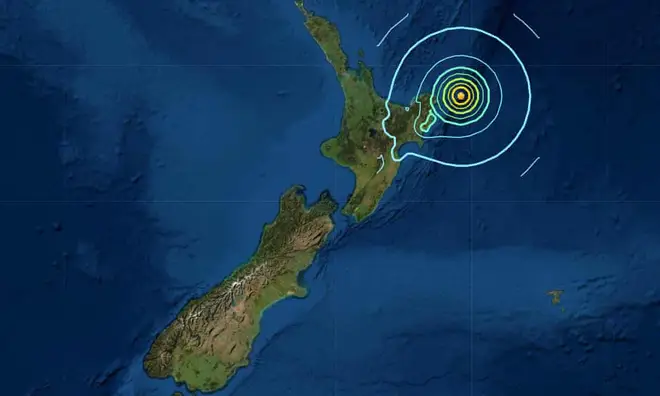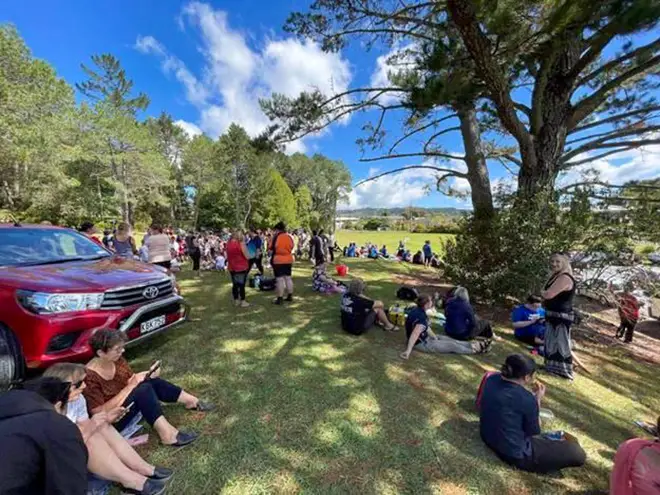
Nick Ferrari 7am - 10am
4 March 2021, 17:17 | Updated: 5 March 2021, 15:06

New Zealanders from the nation's North Island are being allowed to return home after one of the strongest earthquakes to hit the region in modern history.
Residents who live near the coast were urged by the country's Civil Defence to "move immediately to nearest high ground, out of all tsunami evacuation zones, or as far inland as possible".
The magnitude 8.1 quake in the Kermadec Islands region about 620 miles from New Zealand's two main islands was the largest in a series of tremors over several hours, including two earlier quakes that registered magnitude 7.4 and magnitude 7.3.
Small tsunami waves were seen, but the threat caused traffic jams and some chaos in New Zealand as people scrambled to get to higher ground.
Residents have now been allowed to return home, although everyone is being warned to stay away from beaches.

Videos of small wave surges in some places, including at Tokomaru Bay near Gisborne, were taken as people fled for safe ground.
Jennifer Eccles, an earthquake expert at the University of Auckland, said the quake was at the top end of the scale for those involving only the Earth's ocean crust.
"This is about as big as it gets," she said.
She said most quakes larger than magnitude 8.0 tend to occur when a section of more robust continental crust is involved.
TSUNAMI WARNING: Areas that need to evacuate are indicated on this map. Evacuate these areas even if you did not feel the earthquake. DO NOT WAIT. A damaging tsunami is possible. More info at https://t.co/ccVFYQQoBr pic.twitter.com/bnEgZy8ikF
— National Emergency Management Agency (@NZcivildefence) March 4, 2021
It comes after three earthquakes hit the region in a matter of hours, with the first of the tremors causing the National Emergency Management Agency (NEMA) to issue a tsunami warning earlier on Thursday (Friday local time).
The first 7.3 magnitude (M) quake struck shortly before 2:30am local time on Friday 5 March (1:30pm GMT, Thursday 4 March), the second (7.4M) hit at around 6:41am local time and the third (8.1M) shortly before 08:45am.
People were told to flee the affected areas even if they did not feel the third earthquake and evacuation advice overrules the current coronavirus restrictions.
A post on NEMA's Twitter account said: "DO NOT WAIT. A damaging tsunami is possible."
What a tsunami siren sounds like. #eqnz pic.twitter.com/bSRYtuvx5j
— Sacha Judd (@szechuan) March 4, 2021
Residents were told to "walk, run or cycle if possible to reduce (the) chance of getting stuck in traffic" and not to return until being given the all-clear by the Civil Defence.
People were being urged to follow evacuation instructions, including staying out of the water, keeping away from beaches and shore areas, and not going sightseeing.
They were encouraged to share earthquake information with their family, neighbours and friends.
There were no immediate reports of severe damage or casualties after the first tremor, despite residents being told to move to the nearest high ground if they felt "a long or strong quake".
Prime Minister Jacinda Arden wrote on Instagram: “Hope everyone is OK out there – especially on the east coast, who would have felt the full force of that earthquake.
Following the third quake, a NEMA spokesperson wrote on Twitter: "The first waves may reach NZ in the areas around Lottin Point at approximately 9:49am NZDT. Tsunami activity will continue for several hours and the threat must be regarded as real until this warning is cancelled."
After the first tremor, a land and marine tsunami threat was put in place for coastal areas between Cape Runaway and Tolaga Bay and inland flooding had been expected.
Waves were expected to reach up to three metres above normal sea levels but that number was later reduced to one metre.
A spokesperson for NEMA wrote on Twitter at the time: "We have issued a tsunami warning for New Zealand coastal areas following the magnitude 7.3 earthquake near east of the North Island New Zealand.
"There is a land and marine tsunami threat. An EMA will be issued to areas under land and marine tsunami threat."
Another tweet added: "Listen to local civil defence authorities and follow any evacuation instructions. Coastal inundation (flooding of land areas) is expected in areas under Land and Marine threat.
"Areas under land and marine threat: The East Coast of the North Island from Cape Runaway to Tolaga Bay.
"Areas under land and marine threat: The East Coast of the North Island from Cape Runaway to Tolag Bay.. Stay out of the water. Stay off beaches and shore areas. Do not go sightseeing. Share this information."
TSUNAMI WARNING: Listen to local civil defence authorities and follow any evacuation instructions. Coastal inundation (flooding of land areas) is expected in areas under Land and Marine threat. See attached map for affected areas. More info at https://t.co/ccVFYQQoBr pic.twitter.com/KoKouvbYeB
— National Emergency Management Agency (@NZcivildefence) March 4, 2021
The agency warned that the first waves may have reached the coast of New Zealand at around 3:34am local time.
It said tsunami activity "will continue for several hours and the threat must be regarded as real until this warning is cancelled".
Evacuation advice issued by NEMA overrides the current coronavirus rules that are in effect, the agency added.
"Listen to local Civil Defence authorities and follow any instructions. If you are told to evacuate do not stay at home," it wrote on Twitter.
NEMA wrote in an earlier post: "We are assessing whether the M7.3 east of the North Island New Zealand earthquake at 2021-03-05 2:27 am has created a tsunami that could affect New Zealand.
"We will provide an update as soon as the initial assessment has been completed."